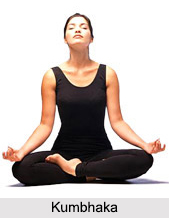 Kumbhaka is a type of pranayama, breathing exercise used in conjunction with meditation and some yoga asanas. It is a Sanskrit term that means breath retention. Effective practice of Kumbhaka in conjunction with pranayama is believed to help prevent and treat a wide variety of diseases, from skin disorders to diabetes.
Kumbhaka is a type of pranayama, breathing exercise used in conjunction with meditation and some yoga asanas. It is a Sanskrit term that means breath retention. Effective practice of Kumbhaka in conjunction with pranayama is believed to help prevent and treat a wide variety of diseases, from skin disorders to diabetes.
Types of Kumbhaka
There are two main types of Kumbhaka: "Antar Kumbhaka", which is the cessation of breath when the inhalation is complete and the lungs are filled up; and "Bahya Kumbhaka", which is the cessation of breath when the exhalation is complete.
Two additional types of Kumbhaka are practiced by the most advanced Yogis: "Sahaja Kumbhaka", which is holding the breath with neither inhalation nor exhalation in mind; and "Kevala Kumbhaka", which does not require inhalation or exhalation and is considered on par with the state of the final stage of union with the Divine.
Advantages of Kumbhaka
The main advantage of Kumbhaka lies in the abdominal contraction and in absorbing huge quantities of oxygen into the body, on account of the air absorption into the human lungs. Kumbhaka also has the following benefits:
•Helps remove impurities from the body
•Boosts physical and mental vitality
•Improves concentration
•Clears and stills the mind
Cautions for Kumbhaka
Few things need to be kept in mind while executing this Kumbhaka technique of the Ujjayi exercise. As long as the chest walls stand firm with the ribs quite elevated, the "glottis" will be able to do its work quite properly. It is thus advised that muscle contraction that happens while breathing in is also to be maintained throughout Kumbhaka technique. Side by side, the abdomen too needs to be compressed and that too carefully.
This article is a stub. You can enrich by adding more information to it. Send your Write Up to content@indianetzone.com




















